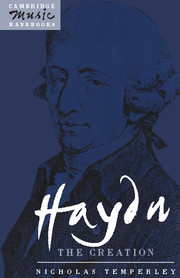Book contents
4 - Composition, performance and reception
Published online by Cambridge University Press: 05 June 2012
Summary
Genesis and composition
It is not known exactly when Salomon handed the Creation libretto to Haydn and asked him to set it to music, but according to Swieten ‘he was just on the point of leaving for Vienna’, which he did on 15 August 1795 at the end of his second visit to London. One account claims that it was not Salomon but François Hippolyte Barthélemon (1741–1808), the French violinist and composer resident in London, who first suggested the idea:
During Haydn's stay in England he was so much struck with the performance of Handel's ‘Messiah’, that he intimated to his friend Barthelemon his great desire to compose a work of a similar kind. He asked Barthelemon what subject he would advise for such a purpose. Barthelemon took up his Bible and said, ‘There, take that, and begin at the beginning!’ Barthelemon assured my father that this was the origin of the idea of the composition of ‘The Creation’.
But whether the idea was Barthélemon's or Salomon's, it was the latter who actually provided the text. Swieten says:
At first sight the material seemed to him [Haydn] indeed well chosen, and well suited to musical effects, but he nevertheless did not accept the proposal immediately; he was just on the point of leaving for Vienna, and he reserved the right to announce his decision from there, where he wanted to take a look at the poem. […]
- Type
- Chapter
- Information
- Haydn: The Creation , pp. 31 - 46Publisher: Cambridge University PressPrint publication year: 1991



